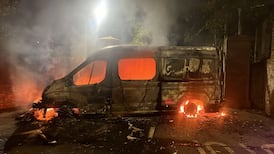In rejecting the allegation by a powerful Trump ally that the Occupied Territories Bill illustrates how Ireland is heading down an “anti-Semitic path” (Republican Senator Jim Risch), the Taoiseach might be tempted to explain that Irish and American anti-fascists fought together against anti-Semitism during the Spanish Civil War. Additionally, in October 1936, ten weeks after the generals rebelled against the elected government in Spain, Irish and Jewish immigrants in London defeated Oswald Mosley’s British Union of Fascists in the Battle of Cable Street.
As the Blackshirts prepared to march from the Tower of London through what Mosley described as a “Jew-ridden and communistic” East End, barricades were erected to block them at Cable Street.
The large Jewish community in the area, mostly refugees from pogroms in Tsarist Russia, lived alongside Irish immigrants, who were mainly dockers. The anti-fascists, locals and reinforcements, chanted “they shall not pass” – the slogan of the Spanish Republic – and prevented mounted police from forcing a way through for the march.
Mosley, a rising star in British politics, with influential backing from the Daily Mail, never recovered from this.
READ MORE
Max Levitas, a Dubliner who grew up in Portobello, known as “Little Jerusalem”, participated in the Cable Street engagement, with his trade unionist father and older brother Maurice. The Jewish Levitas family had moved to London during the Great Depression, and Maurice joined the Irish unit in the International Brigades – which recruited young people around the world to serve in the armed forces of the Spanish government.
The Irish initially joined the British battalion, and some later transferred to the American Abraham Lincoln battalion. About one in three of these US volunteers were Jewish.
Writing home to his mother, one volunteer wrote: “In Spain there are thousands of mothers like yourself who never had a fair shake in life. They got together and elected a government that really gave meaning to their life. But a bunch of bullies decided to crush this wonderful thing.”
This letter summarised the motives behind the international struggle against Franco’s fascists.
Both the American and British battalions suffered heavy casualties at the Battle of Jarama in 1937. Frank Ryan, the Irish unit’s commander, was wounded and travelled home to convalesce. But, as others did, he went back to Spain, knowing that the war could not be won.
Following Franco’s victory in 1939 – military assistance from Hitler and Mussolini proved to be crucial – Ryan remained a prisoner when almost all of the British and American prisoners were repatriated.
Condemned to death, Ryan had a stroke of luck when a New York Times correspondent mentioned him in two reports. In prison with fellow “Internationals”, American comrades remembered him as an “inspiring figure” with a “commanding personality”.
Lou Ornitz, moved from prison to prison, and lucky to be alive as so many others had been executed, remembered Ryan’s courage. “One night he was taken out and as we said good-bye he told us to sing Kevin Barry, and we did as he was led away. He came back a few hours later and I thought he was a ghost.”
Ireland’s brigadistas were not welcomed home as heroes, and a few, such as Michael O’Riordan, were interned in the Curragh. Following the invasion of the Soviet Union in 1941, O’Riordan and Neil Goold made a controversial – to IRA ears – argument about the war: Irish republicans should join the British forces to defeat Hitler-led fascism.
O’Riordan opposed any reliance by the IRA on Germany, and followed Ryan in taking issue with those who believed in all circumstances that “England’s difficulty is Ireland’s opportunity”.
Some of his former comrades in Spain joined the Allied armed forces. Maurice Levitas enlisted in the Royal Army Medical Corps and served in Burma (Myanmar) and India.
Michael Lehane, a Kerry republican, who returned to fight in Spain twice, could not wear a British uniform, and instead joined the Norwegian Merchant Marine. He perished when his ship was sunk by a U-boat in the North Atlantic.
When he went home to Cork, O’Riordan and other former IRA internees set up a new branch of the Labour Party named after Liam Mellows. Within weeks they infuriated the local party.
When a Labour councillor made anti-Semitic remarks, O’Riordan organised a public meeting on the “Jewish question” and dispelled anti-Semitic prejudices so effectively that Jewish people in the audience felt they had no need to speak.
One of them, the lawyer Gerald Goldberg, later donated £5 to the Mellows branch, which led to O’Riordan being accused of attempting “to subvert the party with Jewish money”.
In February 1944, O’Riordan and another Cork comrade were expelled ahead of four others in Dublin as part of Labour’s crackdown on left-wing entryists. Standing as a socialist he narrowly missed a seat in the 1945 local elections, and came third in a by-election the following year.
Goldberg became the first Jewish lord mayor of Cork in June 1977 – the same month post-Franco Spain held its first general election since 1936.















